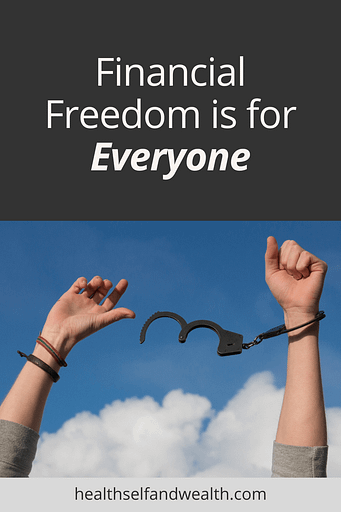
Ahhh financial freedom… the sounds of seagulls squawking and gentle waves crashing into a white sandy shore before retreating. A salty breeze tousles your hair as the sun rays warm your face. Your mind stays quiet, not a single thought could disrupt your deeply rooted sense of peace.
Anyone else picture retirement like that?? Regardless of how you picture your retirement, financial freedom, or financial independence, is for anyone who intends to successfully retire one day.
This is your ultimate guide to financial freedom answering all the most common questions.
- What is financial freedom?
- Why would you want to reach financial freedom?
- How do you reach financial freedom?
- Is financial freedom enough?
Please note I am not a licensed financial advisor. This information is for education purposes only. Every person has a unique financial situation. The best approach will be different for everyone. Accordingly, do your own due diligence before making any financial decision.
What is financial freedom?
Financial freedom is having enough assets to cover your liabilities for life. In other words, you have enough investment/business/real estate income to cover your expenses that you are not dependent on an employer for your financial well-being.
Financial freedom or financial independence is abbreviated as FI. It’s similar to the FI/RE movement, Financial Independence Retire Early.
Here’s the difference in my mind: FI/RE appeals to a small group of people who have the means, discipline, and desire to delay gratification in pursuit of a grander goal. Typically, people have high incomes or spend minimally. If they can do both, then they are well on their way in the pursuit to FI/RE.
The challenge with this approach is that it often requires extreme action to get these extreme results.
While there’s nothing wrong with that, it takes more discipline to ensure you still have balance while chasing your dreams.
Why would you want to reach financial freedom?
While FI/RE is not for everyone, financial freedom is.
Typically most people reach financial freedom/financial independence (FI) in their sixties. But there’s no reason you have to wait that long to reach the magic FI number.
It provides the ultimate financial stability. Essentially once you reach it, you can live your life without worrying about money.
If this were a science fiction novel, financial independence would be like the utopia the main characters try to reach. (Although as you and I both know, nothing is ever perfect.)
Everyone must reach financial independence, unless you never intend to retire, successfully.
Accordingly this guide is for anyone who wants to retire. What will vary though is your unique timeline to FI.
How do you reach financial freedom?
Before you can reach this, you have to figure out what financial independence looks like for you. It will be different for everyone!
Whenever we are talking about a money goal, especially one as important as financial independence, we must take a step back. First you have to take some time to reflect.
Here are some prompts that are going to make you think. Once you go through them, you should have a greater sense of clarity about the life you want to live and how money will support that.
- Who is in your life?
- How do you spend your time?
- What do you value most?
- Where do you live?
- How do you feel?
If you want more prompts like these to further reflect, take a deep dive into defining your best life here.
Once you have an idea of what your dream life looks like, then it’s time to think how money can support that life.
In particular, estimate how much money per year it would take to live the life you’ve defined.
Then apply the rule of 25 and multiply that number by 25. That’s your FI number. That means once you have that amount in your investment accounts, you are financially free.
Financial independence = annual expenses X 25
For example if you wanted to spend $80,000 per year, your FI number would be $2 mil. ($80K X 25 = $2.5 mil)
Now for the really fun math!!! You can reverse engineer this number to estimate out how much you’d need to invest per month to reach it by your target FI date.
Now if you’re not as excited about the math as me, you can steal this free calculator to do the math for you.If you are, whip out your preferred spreadsheet and use the =pmt function or check out this free online calculator.
I must note, this estimate is likely an underestimate. If you can, aim higher than your FI number before declaring yourself free.
For those who want the deets, here’s why this is an underestimate.
- The market returns are not a perfect 7% each year. Accordingly, this inconsistent compounding results in lower returns than a perfect 7% annually.
- It doesn’t account for inflation. (And inflation is at 8% right now, yikes!)
- The rule of 25 only accounts for you living for 30 years after you retire. I don’t know about you but I don’t consider a successful plan being contingent upon certain death.
- The rule of 25 has a 95% success rate. Kristy Shen has some great literature on how to get this up to 99%.
Knowing that this is an underestimate will help ensure your success. I personally take my FI number and multiply it by 1.25. I over estimate by 25% to prepare for all the unknowns I can’t control.
Start with the rule of 25 to estimate your FI number, then decide how much, if any, you want to overshoot it by. It all depends on your unique situation and tolerance for risk.
Is financial freedom enough?
I also need to say this to all my fellow over achievers out there. The best part of this journey to FI is the journey itself.
The human mind is designed to get a dopamine rush through the process of pursuing goals. Notably, dopamine does not come from achieving results.
In other words, your mind releases dopamine right before you start working towards your goals. This is what motivates you to begin. Dopamine is not released when you achieve your results.
Since the joy is in the journey, it may not feel satisfying when you finally reach your FI number. If that happens, often people are tempted to set another goal.
Maybe your original FI number was $2 mil. Then you reach it and maybe you’re content for a while. Then you miss the desire to work towards something so you decide to shoot for $4 mil.
I don’t have answers on how to avoid this perpetual trap of hard work to achieve goals followed by only temporary satisfaction.
An enlightened person may say it’s up to you to choose between peace and pleasure. I can only warn you that it’s human nature to find new goals when you achieve the old ones.
It’s up to you to decide how much is enough. When you are struggling with it, return back to your lifestyle goals.
Conclusion
Financial freedom is for anyone who intends to (successfully) retire one day. It means you’ve reached a point where you have enough money where you no longer need to work to live.
Even though most people retire in their 60s, you don’t need to wait that long to earn your financial freedom if you don’t want to. The more you invest, the faster you’ll reach financial independence.
The amount you choose to invest should be rooted in the lifestyle you intend to live because money simply provides the means to live your best life.
If you still have questions like…
- When can I reach financial freedom?
- How much money will I need to reach financial freedom?
- What happens if I retire when I reach financial freedom?
then you may like the Financial Freedom Spreadsheet because it considers your unique financial situation to help you understand how and when you will reach financial freedom.










[…] Independence | Financial Planning | Investing | Saving Money | Wealth Join the Wealthy Women Club Views […]